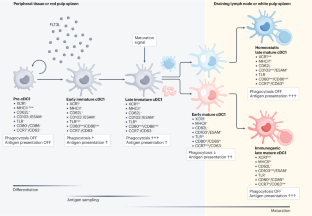Striking a balance: new perspectives on homeostatic dendritic cell maturation
IF 67.7
1区 医学
Q1 IMMUNOLOGY
引用次数: 0
Abstract
Dendritic cells (DCs) are crucial gatekeepers of the balance between immunity and tolerance. They exist in two functional states, immature or mature, that refer to an information-sensing versus an information-transmitting state, respectively. Historically, the term DC maturation was used to describe the acquisition of immunostimulatory capacity by DCs following their triggering by pathogens or tissue damage signals. As such, immature DCs were proposed to mediate tolerance, whereas mature DCs were associated with the induction of protective T cell immunity. Later studies have challenged this view and unequivocally demonstrated that two distinct modes of DC maturation exist, homeostatic and immunogenic DC maturation, each with a distinct functional outcome. Therefore, the mere expression of maturation markers cannot be used to predict immunogenicity. How DCs become activated in homeostatic conditions and maintain tolerance remains an area of intense debate. Several recent studies have shed light on the signals driving the homeostatic maturation programme, especially in the conventional type 1 DC (cDC1) compartment. Here, we highlight our growing understanding of homeostatic DC maturation and the relevance of this process for immune tolerance. Dendritic cells (DCs) act as gatekeepers between immunity and tolerance. Initially, it was postulated that mature DCs promote effector T cell responses and immature DCs promote tolerance. Recent studies have shown instead that two distinct modes of DC maturation exist — homeostatic and immunogenic. Here, Bosteels and Janssens discuss our current understanding of homeostatic DC maturation and how this contributes to immune tolerance, with a focus on the cDC1 compartment.



取得平衡:树突状细胞成熟的新视角
树突状细胞(DC)是免疫与耐受之间平衡的关键守门人。它们有两种功能状态:未成熟或成熟,分别指信息感应状态和信息传递状态。历史上,DC 成熟一词被用来描述 DC 在被病原体或组织损伤信号触发后获得的免疫刺激能力。因此,人们认为未成熟的直流电介导耐受,而成熟的直流电则与诱导保护性 T 细胞免疫有关。后来的研究对这一观点提出了质疑,并明确表明存在两种不同的直流细胞成熟模式,即同源性直流细胞成熟和免疫原性直流细胞成熟,每种模式都有不同的功能结果。因此,不能仅凭成熟标志物的表达来预测免疫原性。DC 如何在平衡状态下被激活并维持耐受性仍是一个激烈争论的领域。最近的一些研究揭示了驱动平衡性成熟程序的信号,尤其是在传统的 1 型 DC(cDC1)中。在这里,我们将重点介绍我们对DC平衡性成熟以及这一过程与免疫耐受的相关性日益加深的认识。
本文章由计算机程序翻译,如有差异,请以英文原文为准。
求助全文
约1分钟内获得全文
求助全文
来源期刊

Nature Reviews Immunology
医学-免疫学
CiteScore
93.40
自引率
0.40%
发文量
131
审稿时长
6-12 weeks
期刊介绍:
Nature Reviews Immunology is a journal that provides comprehensive coverage of all areas of immunology, including fundamental mechanisms and applied aspects. It has two international standard serial numbers (ISSN): 1474-1733 for print and 1474-1741 for online. In addition to review articles, the journal also features recent developments and new primary papers in the field, as well as reflections on influential people, papers, and events in the development of immunology. The subjects covered by Nature Reviews Immunology include allergy and asthma, autoimmunity, antigen processing and presentation, apoptosis and cell death, chemokines and chemokine receptors, cytokines and cytokine receptors, development and function of cells of the immune system, haematopoiesis, infection and immunity, immunotherapy, innate immunity, mucosal immunology and the microbiota, regulation of the immune response, signalling in the immune system, transplantation, tumour immunology and immunotherapy, and vaccine development.
 求助内容:
求助内容: 应助结果提醒方式:
应助结果提醒方式:


